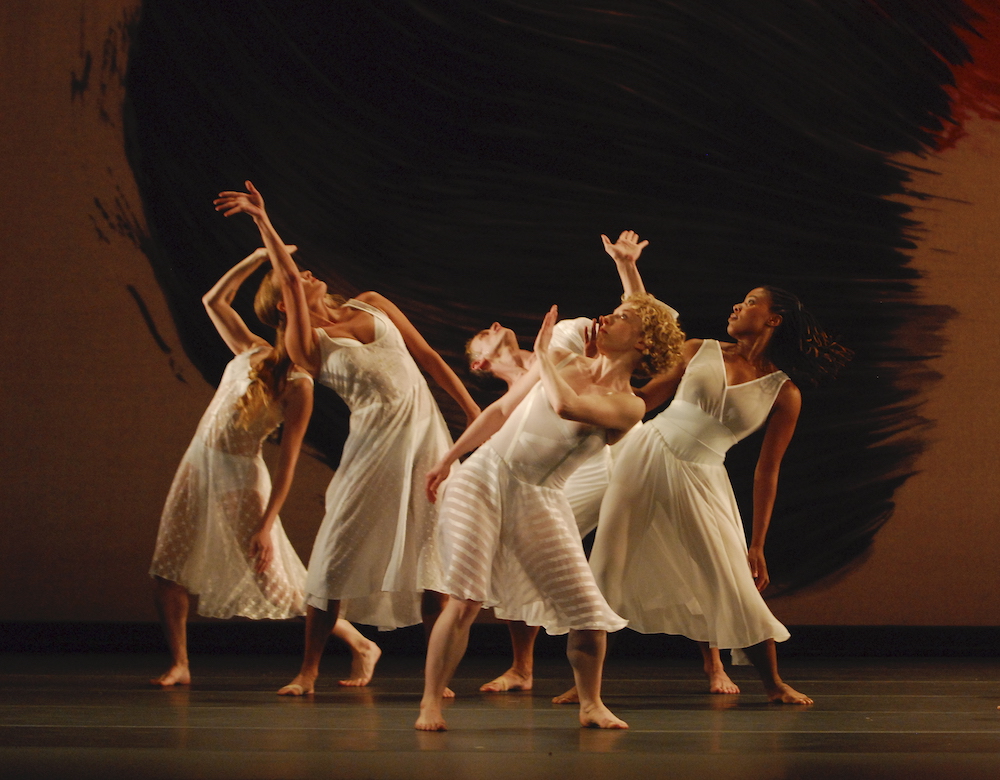Mark Morris Dance Group, long loved by audiences in Berkeley, presented the choreographer’s Mozart Dances this past weekend at Cal Performances’ Zellerbach Hall. The company premiered the work at the Lincoln Center in New York City in August 2006, and performances in Berkeley followed soon after.
The dance is set to two piano concertos and a sonata for two pianos by Mozart. The formidable Inon Barnatan was the pianist, and the Berkeley Symphony was directed by long-time MMDG collaborator, Colin Fowler, who was also the second pianist in the musically dramatic middle section Double.

Morris frequently sets choreography to Baroque and Classical music. The formalism and repeating patterns of the music work well with his aesthetic choices. And the music’s delicacy and measured style provide a contrast and a complement to the roguish in Morris’ style. They graciously and subtly allow him to favor the tongue-in-cheek, slightly camp narrative embedded in his dance.
Virtuosity is shunned in the work except as it appears in the adherence to pattern. This is not to say that the MMDG are not accomplished and talented dancers. They are that. It takes a lot of skill to dance in elaborate organizing forms for over two hours and convey during that entire time a sense of ease and casual playfulness. By virtuosity I mean the kind favored by Balanchine, William Forsythe and Wayne McGregor, which has been rooted in ballet for at least a century and to which modern dance has imposed its own contrasting rigidity of form. Virtuosity that requires mind-boggling speed and sky-high extensions. Hardly a pirouette was to be seen.
After a short few moments of bare-chested male dancers onstage, Eleven, the opening section of Mozart Dances, gave way to seven women costumed in semitransparent dresses revealing their bodies in black bras and panties. They performed the orchestra’s part in the musical competition between the solo piano and orchestra, prancing in synchronous linear patterns to the exuberant and full sounds of the strings. Lauren Grant, the petite dancer who has been with MMDG since 1996, danced the piano part, fashioning a powerful solo dynamic in contrast to the other dancers and orchestra. Her movements were hieroglyphic in their gesture and style. Comic moments bubbled up, dancers would stretch arms out and up, one leg in a low extension until the dancer overbalanced and fell gracefully to the floor.
Double, with two pianists, was danced by the men in black trousers and open shirts. Aaron Loux danced solos throughout. His movements were simple, picturesque as photographic stills, and followed the broad tonalities of the music. The formal dance patterns were dominated by the circle, as the men gathered center stage, holding hands so that movements in one part of the circle were supported or interrupted by a dancer in another part of the circle. Slowly the women returned in black leotards and long transparent skirts, white with a whisper of mauve. They joined the circle with its rising and falling entanglements.
The third section, Twenty-Seven, was built around a series of shifting duets. With the dancers all in white, it was light and bubbling, dramatic and insistent. A bouquet of the improbable confronting the predictable. It was oh-so Mark Morris.
